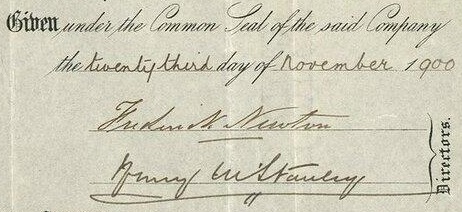Taxonomy is the practice of describing, identifying, naming, and classifying things on the basis of characteristics. Using a predefined list of characteristics makes it easy to register your collectibles in a document, a spreadsheet, or any other database application.
As far as antique securities are concerned, you can define as many characteristics as you need. I usually consider two groups of characteristics :
- those that you derive from the certificate's appearance: physical characteristics
- and those that you get after more research: researched characteristics.
As an example I use a Dutch stock certificate from the Passoeroean Stoomtram-Maatschappij, Dutch for 'Pasuruan Steam Tram Company'.
Physical characteristics
- Issuer : Naamloze Vennootschap Passoeroean Stoomtram-Maatschappij (PSM)
- Type : share
- Denomination : 100 gulden
- Capital/Principal : 500,000 gulden
- Issue date : 1st July, 1905
- Place of issue : 's-Gravenhage, the "old" name for Den Haag
- Registered or bearer : bearer
- Lifecycle status : issued and uncancelled
- Printer : Zuid-Hollandsche Boek- en Handelsdrukkerij
- Colors : blue
- Design & vignettes : borders with scrollwork of leaves and flowers
- Engraver : none mentioned
- Artist : none mentioned
- Language : Dutch
- Security features
- seal : none
- watermark : none
- handwritten signatures : yes
- Notable person (signed by, issued to, transferred to) : none
- Format : vertical
- Medium carrier : paper
- Special remarks : -
This Passoeroean Stoomtram-Maatschappij share from 1905 was printed by the Zuid-Hollandsche Boek- en Handelsdrukkerij. The latter company became part of the Elsevier publishing house in the late 1970s.
Researched characteristics
- Country of issuance : The Netherlands
- Place of operations : Pasuruan, East Java
- Country of operations : Indonesia
- Type of operations : railway
- Era : Ethical Policy program of the Dutch East Indies (1900-WWII)
Once you have specified a certificate's characteristics, you can use that information to find out more about the certificate, its issuer, the latter's location or possible notable persons involved.
The term Naamloze Vennootschap, in short NV, corresponds to similar concepts in other countries such as Aktiebolag (AB), Aktiengesellschaft (AG), Incorporated (Inc), Public Limited Company (Plc), Société Anonyme, Sociedad Anónima and Spółka Akcyjna (SA), Società per Azioni and Societate pe Acțiuni (SpA), Ανώνυμη Εταιρεία (A.E.), etc. In Indonesia the term Perseroan Terbatas (PT) is used.
What have I learned about this antique share certificate?
Sugar producers need a tramway
The illustrated share in the Passoeroean Stoomtram-Maatschappij (PSM) was issued in 1905 during the so-called Ethical Policy program. Aimed at promoting the living conditions of the Indonesians, this Dutch colonial policy comprised these pillars :
- Irrigation, introduction of banking services and subsidies for indigenous industries and handicrafts,
- Education, including the organization of a Dutch school system,
- Migration of people from the over-populated Java to the less densely populated areas of Indonesia.
Unlike the Ethical Policy program, the PSM was a success. The company organized transport of passengers and products such as sugarcane, tea and tobacco for nearly 100 years. Actually sugar cultivation was the main reason to set up this tramway company.
The PSM imported locomotives made by Lokomotivbau Hohenzollern, HANOMAG and Cockerill. The one shown on this picture taken around 1910 is the Cockerill C2201 "Louisa".
image : Tidak Diketahui, Public domain, via Wikimedia Commons
Colonial Indonesia's Liberal Period introduced private (mainly Dutch) entrepreneurship. The Sugar Act of 1870 allowed private companies to start sugar cane plantations in the Dutch East Indies. Soon, the region around Pasuruan saw the startup of several sugar factories. Pasuruan lies in East Java along the coast line between Surabaya and Probolinggo.
To provide cheap and fast rail transport to and from the sugar mills, the government granted several concessions to the PSM for building and operating a railway. The 6km track between Pasuruan and Warung Dowo was inaugurated on May 21, 1896. Others sections followed. The last one was opened in 1912 and connected Warung Dowo with Ngempit over a 5km distance.
Some of PSM's branches were closed under Japanese Occupation during World War II. Others were further closed due to increased competition by road transport. The remainder of the PSM lines are now operated by PT Kereta Api Indonesia.
Oh, did you know that the Indonesian word for tram is trem !
F.L.
Previous posts















